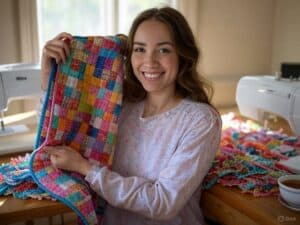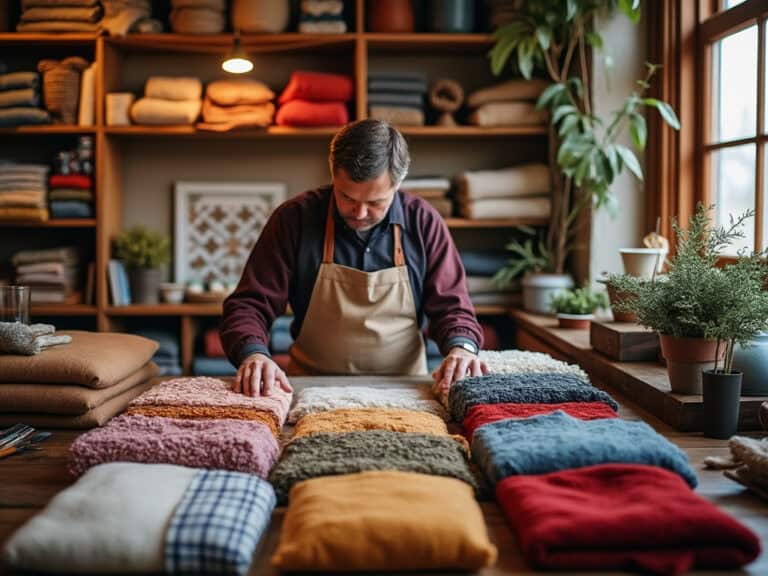When creating warm quilts, I have come to understand that it is important to focus on the fabrics used. I can’t tell you how many times I’ve spent lots of time choosing suitable fabrics and only realized the warmth factor was not present.
The fabrics I have chosen are crucial in ensuring the quilt’s warmth. This is because your fabric selections — including the species, weave, and texture of the fabric — are very important and dictate the overall warmth of the quilt. So, let me share with you some of the fabrics that make my quilts extra warm and cuddly.

1. Warmth Properties Of Different Fabrics, I Learned
While making quilts, I have also come to note that various fabrics have different heat-retaining qualities and this lowers or increases the warmth of your quilt. Here is what I have observed:
Cotton: This material is warm, soft, and absorbent. Widgets made from cotton are especially suitable for reasonably cold conditions since their texture makes them soft and comforting. You get that feeling of receiving a winter blanket from a friend.
Wool: Wool is constructed from crimped fibers and is a great thermal insulator. When the weather is awfully cold, they will act as both a sheer blanket and the fiber texture will trap air and warmth thanks to those fibers. Additionally, the number of stitches per inch in the quilt can significantly enhance its warmth and durability.
Bamboo: A more recent option, bamboo is inherently hypoallergenic and quite incredible at insulating too. I’ve been playing around with it for a while, and guess what – it’s soft and warm!
Then there are the synthetic ones like polyester, fleece, and microfiber known to be created for heat retention. On freezing nights, I’ve used fleece quilts and it’s like being in the arms of your heater.
2. The Connection Between Fabric Weave, Texture, and Warmth in My Quilts
Now, I vividly recollect the first time I worked with a twill fabric that was woven tightly together- it was surreal! More layers of tightly woven fabrics like twill or satin add a lot more density to the fabric which means that a lot more warmth is retained within the fabric.
And then there is the soft and fuzzy feel of brushed fabrics such as flannel – The soft fuzz creates air pockets on the surface that trap the heat as it owns them. One of the most beloved designs, the Log Cabin quilt, benefits greatly from tightly woven fabrics, enhancing both its warmth and aesthetic appeal.
Unlike tighter weaves, the thicker weaves have loose strands, which allow air to seep through easily. Therefore, they are not as effective in preventing heat loss. However, if you overlap them in certain areas, you can still achieve that warm feeling of balance.

How heat-trapping fabrics work
But here’s the interesting part: This may sound highly complex, but it is the scientifically proven phenomenon of heat retention – air pockets within fabrics. These air pockets trap warm air and keep it close to a person’s skin in order to minimize heat loss.
Wool, fleece, and certain synthetic fabrics embedded with metallic threading are great options for fabric that can contain such air pockets. It’s amazing to think how something as simple as fabric could be designed to keep us warm. Using the proper fabric with a specific fiber configuration allows heat to remain inside while the cold is blocked out.
Many of the finest quilts, especially those from Lancaster County, are known for their exceptional heat retention due to the meticulous craftsmanship of local artisans.
3. Brushed Cotton Flannel: My Ultimate Choice for Cozy Quilts
The effectiveness of Brushed Cotton Flannel in Quilts
I guess with time you would have come to the conclusion that brushed cotton flannel is among the fabrics that I cherish most especially for quilts. People don’t only find comfort– it is so soft and the warmth it provides is astonishing.
This particular fabric is a great choice for frigid winters because of its natural insulation. However, my favorite thing about it is that it is also very ventilated, therefore I do not heat up, yet it still ensure that I am warm and comfortable.
In addition to quilts, brushed cotton flannel is also used to create a variety of other warm products such as quillows and baby blankets.
Producing Insulation with the Brushed Surface
If you’ve never experienced brushed cotton flannel before, consider this, you are missing a treat. Many fibers are uprooted over the cloth during the brushing process and they create tiny hollow insulating areas that trap air. The air cavities act as a barrier against cold winds and I am all the more and more covered in coziness.
Transforming Flannel Shirts into Quilting Materials
I have a special weakness for upcycling, especially flannel shirts. I wouldn’t have gotten rid of so many old shirts if I didn’t have the intention to make patchwork quilts out of them. We must not forget that it is also a very eco-friendly project because the quilt would still be your own.
I have made the same out of shirts worn by my relatives and believe the value attached is priceless. Also, each quilt can grab a unique style because flannel shirts come in so many colors and patterns.

4. Jersey Knit: The Style I Love for Surprising Warmth in My Quilts
Reasons Why Tightly Knit Jersey Fits Good for Warm Quilts
Jersey knit- who would have thought it feels so warm for quilts? It’s not only a fabric for T-shirts. The structure of loops knits tight. That is why it is a proper fabric for warm quilts. I did not believe this in the beginning but now I appreciate the fact that the jersey gives a comfort of warmth without heaviness.
Shopping for a jersey knit quilt can be a delightful experience, as you explore the various textures and warmth levels available.
Jersey Fabric Stretch and Comfort Benefits
Let me tell you the thing that I admire about this jersey knit and that is the stretch that it incorporates. It’s elastic, and I can see it when I wrap it around my quilt. When I wrap myself around it, it is pure comfort. It’s like wearing that good warm sweater that you just never want to take off.
Tips and Tricks for Quilting with Jersey Fabric
Let’s be honest, quilting with a jersey is not an easy affair. I know this as the first time I attempted this, I ended up with several stretchy disasters. However, after some practice and problems here are a few recommendations that I would make:
Support the jersey: The first thing to do is make sure that the jersey does not distort due to any stretching. When I am quilting, I prefer using an iron-on stabilizer.
Select the appropriate tools: It may be necessary to use ballpoint needles, as well as threads made from polyester.
Use stable backing: Remember if you want the shape of your quilt to remain constant, you should use a stable fabric like cotton as the backing fabric.
Prewash jersey: Prewash your jersey to prevent shrinkage after the fabric has been used.
5. How I Layer Fabrics to Maximize Warmth in My Handmade Quilts
Layering To Make Thicker Quilts More Effective
I have discovered my favorite technique to make quilts warmer: layering. It is like making a comfortable sandwich. I begin with a thick soothing close-woven fabric like cotton; my second layer consists of a warm jersey knit fabric. To prevent heat loss, I put some cotton flannel on top which gives that nice fluffy and warm feeling.
In the hand of seamstresses or quilters, correct layering of fabric results in the intermingling of each fabric’s heat-retaining features, thereby making the entire quilt practically warmer.
Utilising Various Warm Fabrics For Further Effect
When doing fabric combinations, I present all of them in the order answered to me. Two materials, doing different jobs, are quite uneasy: mixing the loft of flannel with the loops of jersey knit is doing great. Last but not least, they should be complementary in color and care requirements.
The best practices for working on a quilt when the covers are heavy.
Sewing and quilting with heavy fabrics can be challenging. I use lightweight interfacing on my quilts to keep the structure but they are not as bulky as the quilt. You must use thick needles and polyester thread when stitching through thick fabric layers.

6. Care and Maintenance
It is vital to take care of your quilt so that it maintains warmth and coziness. Mine gets washed in cold water on a gentle cycle — this way nothing gets damaged and the klilts fabrics remain intact. Load of fabric softeners. When drying, I like to air dry (when I can!) to maintain the original shape of the quilt.
Tips for Maintaining the Fabric Softeners and Heat Retaining Capacity of the Quilts Over the Years
To keep the fabric soft, I do not go overboard with the fabric softeners — just a little added dose of white vinegar during the rinse cycle does the job. Outside of the laundry basket, it keeps moisture in without compromising the fabric’s ability to breathe.
Things to Keep in Mind While Storing The Quilts after Use so that the Warmth is Not Lost
Before storing my quilts away I first ensure that the entire quilt is dry and place them inside a breathable cotton bag. I mean the last thing in my mind is to have my quilt’s heat and softness destroyed and engulfed by a plastic bag these days.
All in all, I can guarantee you that these processes and a few more that I have not mentioned will enable your handmade quilts to always be cozy and warm throughout the years to come. Try all the different fabrics, and add different layers and approaches to looking after the quilts that best will suit you, and relax and enjoy the warm nights cozied in the perfect quilt of yours!







